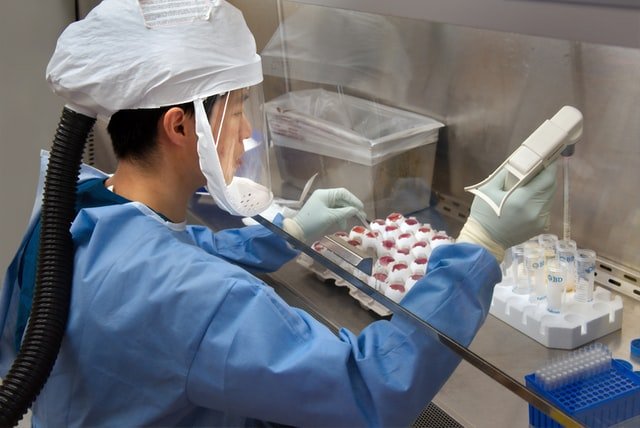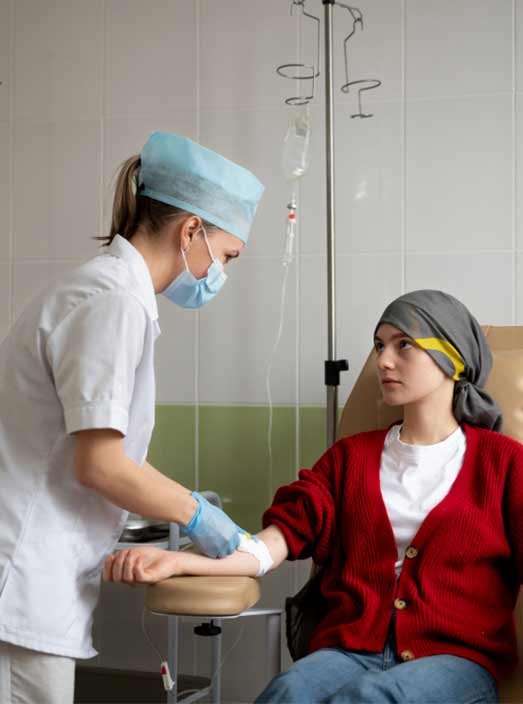Stomach Cancer
- Biotexus
- August 27, 2025
About the stomach
The stomach is positioned in the upper abdomen and is responsible for food digestion. When food is ingested, it travels down the esophagus, a muscular tube that links the throat to the stomach. The meal is then absorbed by the stomach. The stomach mixes the food and secretes gastric juices that aid in the digestion and breakdown of the meal. The meal subsequently enters the small intestine for additional digestion.
Types of stomach cancer
Stomach cancer, also known as gastric cancer, develops when healthy cells in the stomach become aberrant and out of control. A tumor might be malignant or benign. A cancerous tumor is malignant, which means it can develop and spread to other regions of the body. A benign tumor is one that can develop but will not spread. Cancer can start in any area of the stomach. It can also spread to surrounding lymph nodes and other regions of the body, including the liver, bones, lungs, and a woman’s ovaries.
Risk Factors
A person’s chance of acquiring stomach cancer may be increased by the following factors:
Age. Stomach cancer is more frequent in adults over the age of 55. The majority of stomach cancer patients are in their 60s and 70s.
Gender. Men are twice as likely as women to have stomach cancer.
Bacteria. Helicobacter pylori, often known as H. pylori, is a common bacteria that causes stomach inflammation and ulcers. It is also one of the leading causes of stomach cancer. H. pylori testing is accessible, and an infection can be treated with medications.
Family history and genetics. People who have a parent, child, or sibling who has had stomach cancer are more likely to have it themselves.
Race/ethnicity. Black, Hispanic, and Asian persons are more likely to develop stomach cancer than white people.
Diet. A high-salt diet has been related to an increased risk of stomach cancer. This includes foods preserved by drying, smoking, salting, or pickling, as well as foods with a high salt content. Consuming fresh fruits and vegetables may reduce the risk.
Previous surgery or health conditions. People with stomach cancer are more likely to have had stomach surgery, pernicious anaemia, or achlorhydria.
Workplace exposure. Certain dusts and fumes can raise the chance of getting stomach cancer.
Tobacco and alcohol. Tobacco usage and excessive alcohol use may raise the chance of getting stomach cancer.
Obesity. A man’s chance of having stomach cancer rises with his body weight. Obesity does not appear to raise a woman’s risk of stomach cancer.
Symptoms
Stomach cancer is commonly missed at an early stage because it lacks particular symptoms. When symptoms do appear, they may be ambiguous and include those mentioned below. It’s crucial to note that these symptoms can be caused by a variety of ailments, including a stomach virus or an ulcer.
Treatment
Stomach cancer may be treated with surgery, radiation therapy, chemotherapy, targeted therapy, or immunotherapy. Descriptions of the common types of treatments used for stomach cancer are listed below.
Surgery
During an operation, the tumor and some surrounding healthy tissue are removed. The type of surgery required is determined on the stage of the malignancy.
Some doctors may offer a non-surgical therapy termed endoscopic mucosal resection for extremely early stage (T1a) cancer. The tumor is removed with an endoscope in this procedure.
When the cancer is in its early stages (stages 0 or I), surgery is done to remove the cancerous portion of the stomach and adjacent lymph nodes. This is referred to as a subtotal or partial gastrectomy. The residual portion of the stomach is connected to the esophagus or small intestine during a partial gastrectomy.
Radiation therapy
The use of high-energy x-rays or other particles to eliminate cancer cells is known as radiation therapy. A radiation therapy regimen, or schedule, typically consists of a predetermined number of treatments administered over a certain time period. External-beam radiation treatment, which delivers radiation from a machine outside the body, is commonly used to treat stomach cancer. Radiation treatment can be performed either before or after surgery to diminish the size of the tumor or to eradicate any leftover cancer cells.
Therapies using medication
The use of drugs to eliminate cancer cells is known as systemic therapy. This drug is administered through the circulation in order to reach cancer cells throughout the body.
Common ways to give systemic therapies include an intravenous (IV) tube placed into a vein using a needle or in a pill or capsule that is swallowed (orally).
The types of systemic therapies used for stomach cancer include:
• Chemotherapy
• Targeted therapy
• Immunotherapy
Each of these types of therapies are discussed below in more detail.
Chemotherapy :
Chemotherapy is the use of medications to eradicate cancer cells, often by preventing cancer cells from growing, dividing, and proliferating.
Chemotherapy can be used to kill cancer that remains after surgery, limit tumor development, or alleviate cancer-related symptoms. It can also be used in conjunction with radiation therapy. There is currently no one standard chemotherapy treatment regimen that is utilized globally.
Targeted therapy :
Targeted therapy is a type of cancer treatment that targets specific genes, proteins, or the tissue environment that contributes to cancer development and survival. This sort of therapy inhibits cancer cell development and spread while protecting healthy cells. The targets of all cancers are not the same.
Targeted therapy for stomach cancer comprises the following treatments:
HER2-directed treatment Some tumors may produce an excessive amount of a protein known as human epidermal growth factor receptor 2. (HER2). This is referred to as “HER2-positive cancer.”
Anti-angiogenesis therapy. Anti-angiogenesis treatment aims to halt angiogenesis, or the process of forming new blood vessels. Because tumors require the nutrients given by blood vessels to develop and spread, anti-angiogenesis medicines aim to “starve” the tumor.
Immunotherapy :
Immunotherapy, also known as biologic treatment, is intended to increase the body’s natural defenses against cancer. It employs materials either from the body or created in a laboratory to improve, target, or restore immune system performance.
.



















